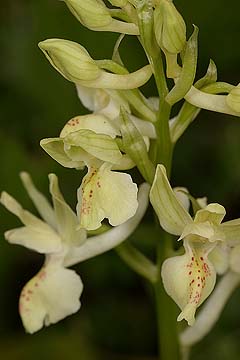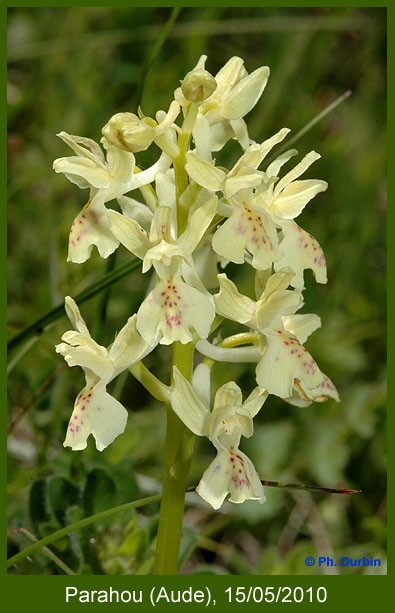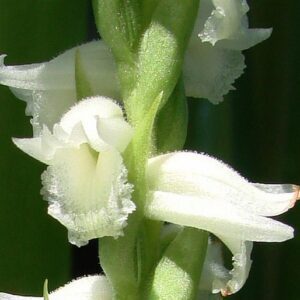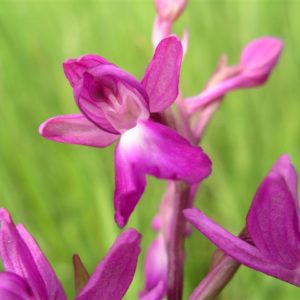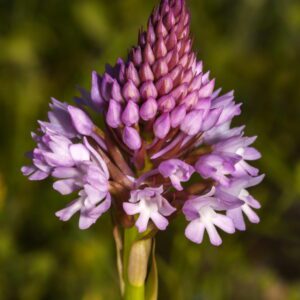€ 0,00
Beschreibung
Provence-Knabenkraut oder Französisches Knabenkraut – Provence orchid
Syn.:
Orchis cyrilli TENORE (1815)
Orchis pallens SAVI (1798)
Orchis leucostachys GRISEBACH (1846)
Androrchis provincialis TYTECA & KLEIN (2008)
English:
Distribution:
The range of this species extends from the north of the Iberian Peninsula
across southern France, the Tyrrhenian Islands, Italy and Sicily, Greece
and the Aegean Islands to the western Caucasus. She is missing in Cyprus.
In the north, on the southern edge of the Alps, it reaches the distribution
limit with isolated occurrences in Swiss Ticino and Misox. The southernmost
occurrences are in Sicily and Crete.
Roughly speaking, Orchis provincialis occurs mainly in the northern
Mediterranean area.
In Sardinia, the focus of distribution is in the provinces of Sassari
and Nuoro, but there are also occurrences in the south and west of the
island that are somewhat less common.
Location:
sunny to semi-shady in fresh to slightly damp places along roads and paths
(especially on Sardinia), sparse deciduous and coniferous forests or also
in grassy areas of the Phrygana.
Mountain meadows and extensively used pastures are less common among their
habitats.
It tolerates moderately calcareous as well as slightly acidic substrates.
In terms of moisture, too, it is not too demanding and sometimes also
occurs on dry marsh grassland.
Their populations are often quite rich in individuals.
Vertically, the deposits are between 0 - 1700 m above sea lev
heyday:
from late March to early June, with Sardinia peaking in the second half
of April.
Characteristics:
Habitus: growth height approx. 15-30 cm, striking plant due to the
light-colored inflorescence, which sometimes becomes quite strong,
but is rather dainty in specimens with few flowers;
at the base of the stem with 3 - 7 narrow, lanceolate, dark green and
heavily spotted leaves, which mostly lie flat on the ground and are arranged in a rosette, 2 - 3 more leaves follow upwards, enveloping the stem
Inflorescence lax, with 5 - 20 flowers, bracts membranous pale light green,
about as long as the ovary.
Flowers pale light yellow, slightly lighter than Orchis pallens
Sepala: Lateral 9 - 14 mm long and 4 - 6 mm wide, ovoid, steeply erect
and protruding backwards, occasionally slightly wavy at the edge,
the middle one inclined over the petals and columns
Petala same coloring as Sepala, distinctly smaller than Sepala and tilted
forward protectively as a helmet over the gynostemium
Lip: 8 - 13 mm long, faintly three-lobed with a bifurcated middle lobe,
curved "sheep-nose-shaped" when viewed from the side, spread wider than long, light yellow in the basic colour, but slightly more intensely yellow in color than the other petals, from the base of the lip to the center of the lip with marked with brown-red dots, which are larger and more conspicuous than in Orchis pauciflora; Lateral flaps knocked down.
Spur curved upwards, up to 20 mm long, about as long as the ovary,
occasionally somewhat thickened at the end, otherwise blunt-ended.
Scar cavity relatively large, somewhat taller than wide, without red tones,
pollinaria yellow, becoming darker as the anthesis progresses.



